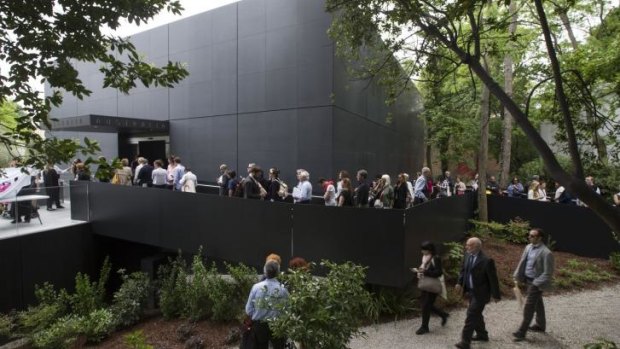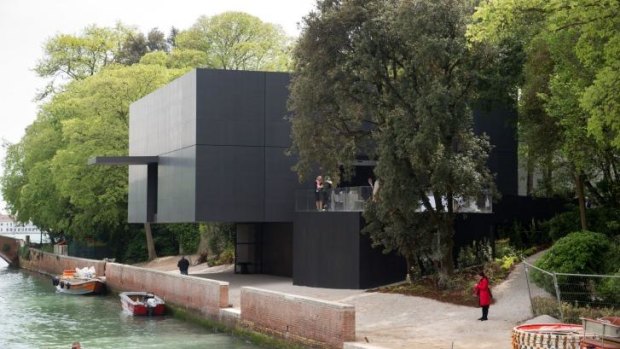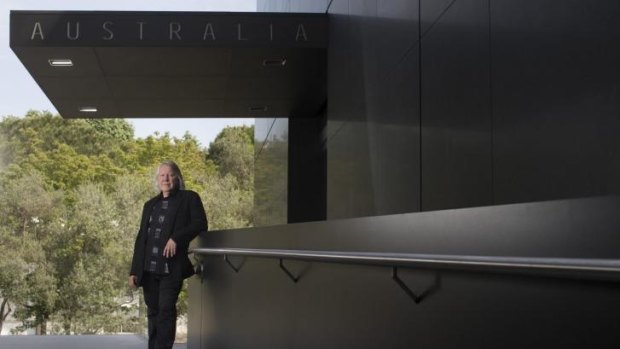This was published 8 years ago
New Venice Biennale pavilion a monumental statement displaying no trace of Australiana
By John McDonald
Venice has been thrilled by the idea of a new Australian pavilion in the Giardini, where Biennales have been held since 1893. There has been a lot of press and many photos, the favourite one showing the great black cube leaning out over the canal that bisects the exhibition area.
One approaches the new building through a familiar track between other national pavilions, but if the previous pavilion designed by Philip Cox had the feel of a beach house, its replacement looms like the Kaaba in Mecca. It's an imposing sight but also very simple.

Art lovers queue to see inside the new Australian Pavilion in the Giardiani at the Venice Biennale.Credit: Angus Mordant
Despite all the daring designs for art galleries architects have produced in recent years the best may be a simple cube – and that is precisely what Denton Corker Marshall (DCM) has given us. The geometric simplicity is disarming, as it is designed to display no trace of "Australiana". There is no corrugated iron, as seen in the work of Cox or Glenn Murcutt; no echoes of the shearing shed, as in Richard Johnson's design for the National Portrait Gallery in Canberra.
It might be disappointing that the black granite cladding has been sourced from China, not Australia, but unlike the new Anzac Memorial in Wellington, where great significance is given to the symbolism of red sandstone (sourced from India!), the new pavilion takes pride in its abstraction.

Imposing: The new pavilion makes a virtue of geometric simplicity.Credit: Venturelli
The building could represent any nation on earth with equal efficiency. It is a statement of our contemporaneity; of our willingness to shed the cliches of Australian identity. It demands that Australian work be judged on the same terms as the art of Europe or the United States, not as the product of a provincial outpost. The black granite might seem out-of-character, but every almost new Australian film is obsessed with dark themes. In cultural terms we are rapidly repudiating our "sun and surf" image.
The architects' ingenuity is best displayed in the panels that may be opened on three sides to let in natural light. When the building is not being used these panels fall back into place to create a black box. DCM describe the structure as "a sculptural object", which sounds slightly pretentious, but in this instance seems completely justified.
One of the original ideas was to have a white space inside the black granite cube, but featured artist Fiona Hall has painted the room black for an installation that is busy, complex and encyclopaedic in its preoccupations. It provides a vivid demonstration on the versatile nature of the design. The architects have done away with interior walls, creating an interior that is pure volume. Hall has exercised her right to construct a room-within-a-room, employing a square arrangement of linked vitrines.
Already the joust between artist and architects has begun, but there is virtually no resistance from DCM. By contrast, the former pavilion was such a difficult space spread out over two levels, that many artists chose to plunge the building into darkness and pick out works with spotlights.

Architect John Denton outside the new Denton Corker Marshall-designed Australian pavilion.Credit: Angus Mordant
Many of the advantages of the new structure are found beneath the exhibition level, where there is generous storage space, a staff room and a bathroom. There is also a heavy-duty elevator that rises up directly through the floor. On the roof one finds solar panels – the first to be installed on a national pavilion, while the interior lighting is state-of-the-art. Not bad for a total outlay of $7.5 million, with only $1 million being provided by the Australian government and the rest raised by private donations.
It's pleasing that the old pavilion has been dismantled and is being repatriated by Melbourne restaurateur Ronnie Di Stasio. Although it was always seen as a "temporary" solution, it would have been disrespectful to simply demolish a structure that has housed 13 exhibitions since its inauguration in 1988.
The new pavilion is made to last, having a monumental dimension. The challenge for the Australia Council will be to choose artists who are capable of creating work of sufficient impact to take advantage of such a large, neutral space. For while this interior may seem willing to accommodate work of any persuasion, mediocrity will have nowhere to hide. There are no longer any excuses. Future Australian representatives will have to produce the goods.